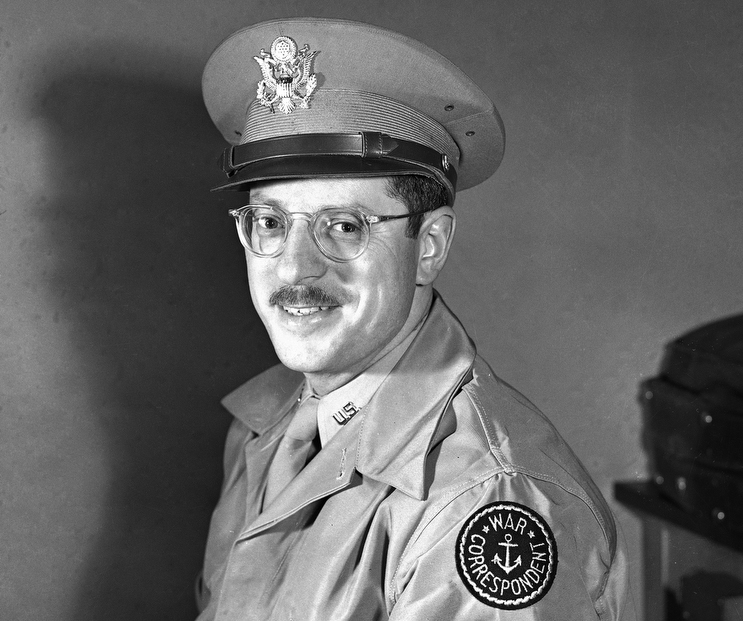
The Story behind the most famous war photograph in History
(Editors note: this story was first published February, 1995 and Joe Rosenthal died on Aug. 20 2006 at 94 years old.)
By MITCHELL LANDSBERG,
AP National Writer
SAN FRANCISCO (AP) — Fifty years ago this month, a young Associated Press photographer named Joe Rosenthal shot the most memorable photograph of World War II, a simple, stirring image of five Marines and one Navy corpsman raising the flag at Iwo Jima.
It took but a sliver of time: 1-400th of a second.
It has consumed the past half-century of Joe Rosenthal’s life.
He has been called a genius, a fraud, a hero, a phony. He has been labeled and relabeled, adored and abused, forced to live and relive, explain and defend that day atop Mount Suribachi on each and every day that has followed, more than 18,000 and counting. “I don’t think it is in me to do much more of this sort of thing,” he said during an interview — his umpteen-thousandth — about Iwo Jima. “I don’t know how to get across to anybody what 50 years of constant repetition means.”
Rosenthal is 83 now, nearly blind, a pudgy man with a dapper white mustache and a horseshoe of white hair curving around the back of a largely bald head. He lives alone in San Francisco, near Golden Gate Park, in a little apartment largely given over to stacks of correspondence and documentation related to Iwo Jima.
In 1945, he was 33, too nearsighted for military service, short and athletic, with a brushy brown mustache and a head full of tight brown curls.
As an AP photographer assigned to the Pacific theater of the war, he had already distinguished himself — and shown a streak of bravado — in battles at New Guinea, Hollandia, Guam, Peleliu and Angaur.
No one remembers Rosenthal for those pictures now.
There is only Iwo. Bloody Iwo. It is the battle that Joe Rosenthal will fight until he dies.
We remember Iwo Jima for two good reasons.
One is that it was the costliest battle in Marine Corps history. Its toll of 6,821 Americans dead, 5,931 of them Marines, accounted for nearly one-third of all Marine Corps losses in all of World War II.
The other is Joe Rosenthal’s picture.
It has been called the greatest photograph of all time. It may well be the most widely reproduced. It served as the symbol for the Seventh War Loan Drive, for which it was plastered on 3.5 million posters. It was used on a postage stamp and on the cover of countless magazines and newspapers. It served as the model for the Marine Corps War Memorial in Arlington, Va., a symbol forever of the valor and sacrifices of the U.S. Marines.
As a photograph, it derives its power from a simple, dynamic composition, a sense of momentum and the kinetic energy of six men straining toward a common goal, which for one man has slipped just out of grasp. “It has every element. … It has everything,” marveled Eddie Adams, a former AP photographer who took another picture that helped sum up a war — one of a South Vietnamese police chief executing a suspect.
Of Rosenthal’s picture, he added: “It’s perfect: The position, the body language. … You couldn’t set anything up like this — it’s just so perfect.”
And therein lies the problem. Some people think Rosenthal’s picture is too perfect.
For 50 years now, Rosenthal has battled a perception that he somehow staged the flag-raising picture, or covered up the fact that it was actually not the first flag-raising at Iwo Jima.
All the available evidence backs up Rosenthal. The man responsible for spreading the story that the picture was staged, the late Time-Life correspondent Robert Sherrod, long ago admitted he was wrong. But still the rumor persists.
In 1991, a New York Times book reviewer, misquoting a murky treatise on the flag-raising called “Iwo Jima: Monuments, Memories and the American Hero,” went so far as to suggest that the Pulitzer Prize committee consider revoking Rosenthal’s 1945 award for photography.
And just a year ago, columnist Jack Anderson promised readers “the real story” of the Iwo Jima photo: that Rosenthal had “accompanied a handpicked group of men for a staged flag raising hours after the original event.”
Anderson later retracted his story. But the damage, once again, had been done.
Rosenthal’s story, told again and again with virtually no variation over the years, is this:
On Feb. 23, 1945, four days after D-Day at Iwo Jima, he was making his daily trek to the island on a Marine landing craft when he heard that a flag was being raised atop Mount Suribachi, a volcano at the southern tip of the island.
Marines had been battling for the high ground of Suribachi since their initial landing on Iwo Jima, and now, after suffering terrible losses on the beaches below it, they appeared to be taking it.
Upon landing, Rosenthal hurried toward Suribachi, lugging along his bulky Speed Graphic camera, the standard for press photographers at the time. Along the way, he came across two Marine photographers, Pfc. Bob Campbell, shooting still pictures, and Staff Sgt. Bill Genaust, shooting movies. The three men proceeded up the mountain together.
About halfway up, they met four Marines coming down. Among them was Sgt. Lou Lowery, a photographer for Leatherneck magazine, who said the flag had already been raised on the summit. He added that it was worth the climb anyway for the view. Rosenthal and the others decided to continue.
The first flag, he would later learn, was raised at 10:37 a.m. Shortly thereafter, Marine commanders decided, for reasons still clouded in controversy, to replace it with a larger flag.
At the top, Rosenthal tried to find the Marines who had raised the first flag, figuring he could get a group picture of them beside it. When no one seemed willing or able to tell him where they were, he turned his attention to a group of Marines preparing the second flag to be raised.
Here, with the rest of the story, is Rosenthal writing in Collier’s magazine in 1955:
“I thought of trying to get a shot of the two flags, one coming down and the other going up, but although this turned out to be a picture Bob Campbell got, I couldn’t line it up. Then I decided to get just the one flag going up, and I backed off about 35 feet.
“Here the ground sloped down toward the center of the volcanic crater, and I found that the ground line was in my way. I put my Speed Graphic down and quickly piled up some stones and a Jap sandbag to raise me about two feet (I am only 5 feet 5 inches tall) and I picked up the camera and climbed up on the pile. I decided on a lens setting between f-8 and f-11, and set the speed at 1-400th of a second.
“At this point, 1st Lt. Harold G. Shrier … stepped between me and the men getting ready to raise the flag. When he moved away, Genaust came across in front of me with his movie camera and then took a position about three feet to my right. ‘I’m not in your way, Joe?’ he called.
“‘No,’ I shouted, ‘and there it goes.’
“Out of the corner of my eye, as I had turned toward Genaust, I had seen the men start the flag up. I swung my camera, and shot the scene.”
Rosenthal didn’t know what he had taken. He certainly had no inkling he had just taken the best photograph of his career. To make sure he had something worth printing, he gathered all the Marines on the summit together for a jubilant shot under the flag that became known as his “gung-ho” picture.
And then he went down the mountain. At the bottom, he looked at his watch. It was 1:05 p.m.
Rosenthal hurried back to the command ship, where he wrote captions for all the pictures he had sent that day, and shipped the film off to the military press center in Guam. There it was processed, edited and sent by radio transmission to the mainland.
On the caption, Rosenthal had written: “Atop 550-foot Suribachi Yama, the volcano at the southwest tip of Iwo Jima, Marines of the Second Battalion, 28th Regiment, Fifth Division, hoist the Stars and Stripes, signaling the capture of this key position.”
At the same time, he told an AP correspondent, Hamilton Feron, that he had shot the second of two flag raisings that day. Feron wrote a story mentioning the two flags.
The flag-raising picture was an immediate sensation back in the States. It arrived in time to be on the front pages of Sunday newspapers across the country on Feb. 25. Rosenthal was quickly wired a congratulatory note from AP headquarters in New York. But he had no idea which picture they were congratulating him for.
A few days later, back in Guam, someone asked him if he posed the picture. Assuming this was a reference to the “gung-ho shot,” he said,”Sure.”
Not long after, Sherrod, the Time-Life correspondent, sent a cable to his editors in New York reporting that Rosenthal had staged the flag-raising photo. Time magazine’s radio show, “Time Views the News,” broadcast a report charging that “Rosenthal climbed Suribachi after the flag had already been planted. … Like most photographers (he) could not resist reposing his characters in historic fashion.”
Time was to retract the story within days and issue an apology to Rosenthal. He accepted it, but was never able to entirely shake the taint Time had cast on his story.
A new book, “Shadow of Suribachi: Raising the Flags on Iwo Jima,” offers the fullest defense yet of Rosenthal and his picture.
In it, Sherrod is quoted as saying he’d been told the erroneous story of the restaging by Lowery, the Marine photographer who captured the first flag raising.
“It was Lowery who led me into the error on the Rosenthal photo,” Sherrod told the authors, Parker Albee Jr. and Keller Freeman. “I should have been more careful.”
Rosenthal, who was to become close friends with Lowery in the years after Iwo Jima, rejects this explanation. “I think that is a twist that has been put on by Sherrod,” Rosenthal said. He believes the source of the misunderstanding was his response to the question about his picture being posed.
It is probably moot. Rosenthal is the only party to the dispute who is still alive. His attitude now is mostly one of forgiveness and acceptance. So many years, after all, have passed.
There is still, of course, the issue of whether the second flag-raising was noteworthy enough to have been enshrined as a historical icon. Here, the facts are of little use; all that matters is interpretation.
To be sure, it didn’t help that the Marine Corps and most of the wartime press conveniently glossed over the fact of the first flag-raising. This helped foster a public notion of cover-up.
But whether or not there was a cover-up (Albee and Freeman are persuasive in arguing that the Marine brass decided to put a lid on the first flag-raising), was the second flag-raising worthy of Rosenthal’s picture?
Some vehemently argue no.
“They call that the Iwo Jima flag-raising, which it ain’t,” declared Charles Lindberg, a retired electrician in Richfield, Minn., who is the last surviving member of either flag-raising – in his case, the first.
“It’s a good picture,” Lindberg conceded. “I even told Joe Rosenthal that it was a good picture. But me and him get into a few arguments.”
That is because Lindberg, like others in the first-flag raising, believed that all the glory was showered on the second flag-raisers, who were less deserving.
Rosenthal doesn’t argue that one group was more deserving than another. “In my own opinion, any one of those troops who had their feet on Iwo Jima is a hero.”
The fact is that neither set of flag-raisers encountered serious resistance from the Japanese as they scaled Mount Suribachi that day. And in retrospect, the scaling of Mount Suribachi was not the great turning point in the battle that it may have seemed: The fighting at Iwo Jima continued for 31 more days.
The other, undeniable fact is that both groups took part in some of the fiercest combat of the war. Five of the 11 men in the two flag-raisings never left Iwo Jima alive.
Perhaps the best argument for Rosenthal’s photo is simply that it is powerful on a symbolic, not a literal, level. Americans responded to it because it was a stirring image of the victory they so badly craved. On that level, it is unassailable.
Marianne Fulton, chief curator of the International Center of Photography at George Eastman House in Rochester, N.Y., said the photo must be seen in the context of a perilous time.
“You’re worried about your life, your family, the future of the nation, and this really incredible picture of strength and determination comes out. A picture like that is a real gift.”
For Joe Rosenthal, Iwo Jima brought fame but not fortune, acclaim but not overwhelming success. He spent the rest of his career as a workaday photographer at the San Francisco Chronicle, shooting politicians and drug dealers, fires and parades.
He scoffs at the notion of being included among the “great” photographers. But they include him in their company. Carl Mydans, the renowned Life magazine photographer, offers this explanation for Rosenthal’s immortality: “If you can get the right moment, the instant, it stays around forever.”
And so it will be with Rosenthal.
He doesn’t have a copy of the Iwo Jima picture hanging in his apartment; only an etching of it and two cartoons lampooning it. He is modest to the point of self-deprecation.
Still, when he was once asked if he would rather that some other photographer had taken the flag-raising shot, he shot back: “Hell, no! Because it of course makes me feel as though I’ve done something worthwhile. My kids think so — that’s worthwhile.”
On one wall of Rosenthal’s cluttered living room is a framed photograph of seven bleary war correspondents at Guadalcanal. They have just stumbled out into the bright light of morning after a night of drinking and card-playing. If they felt the way they look, it had been a long, long night.
In the center of the picture is Rosenthal, scratching the stubble on his chin, looking a little bemused and a little cockeyed, while a Newsweek correspondent next to him drapes a hand over his shoulder for support. The whole picture has a washed-out, overexposed look, perfectly matching the mood of its squinting subjects.
Standing now in his living room, Rosenthal looks at it fondly.
“That,” he declares with a proud chortle, “is the greatest photograph of World War II.”
THE PHOTOGRAPHS:
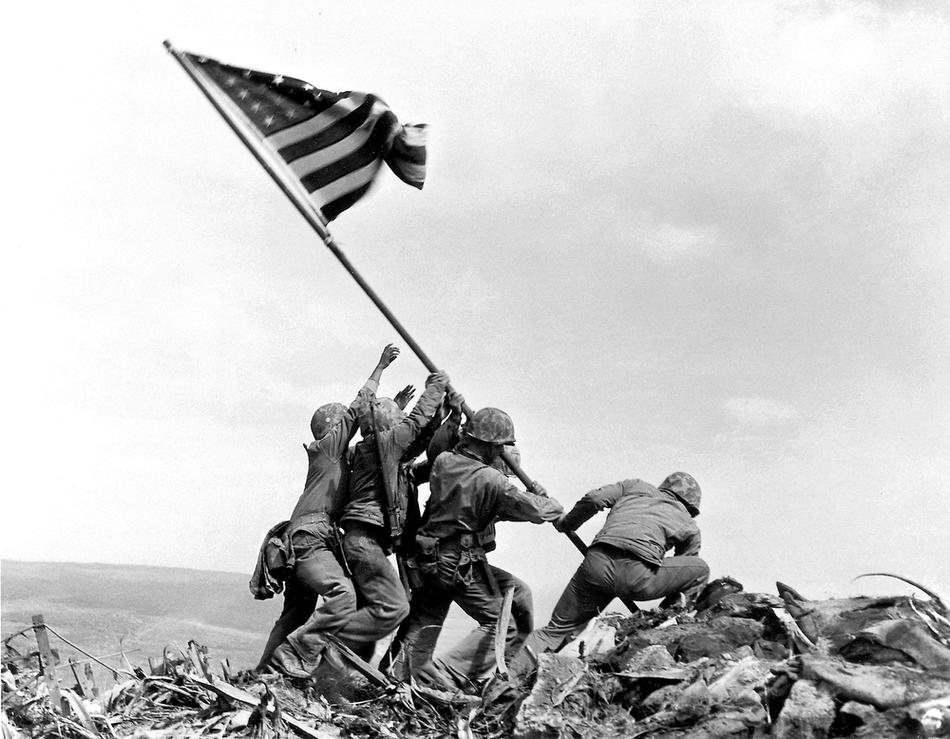
U.S. Marines of the 28th Regiment of the Fifth Division raise the American flag atop Mt. Suribachi, Iwo Jima, on Feb. 23, 1945. Joe Rosenthal, who won a Pulitzer Prize for his immortal image of six World War II servicemen raising an American flag over battle-scarred Iwo Jima. (AP Photo/Joe Rosenthal)
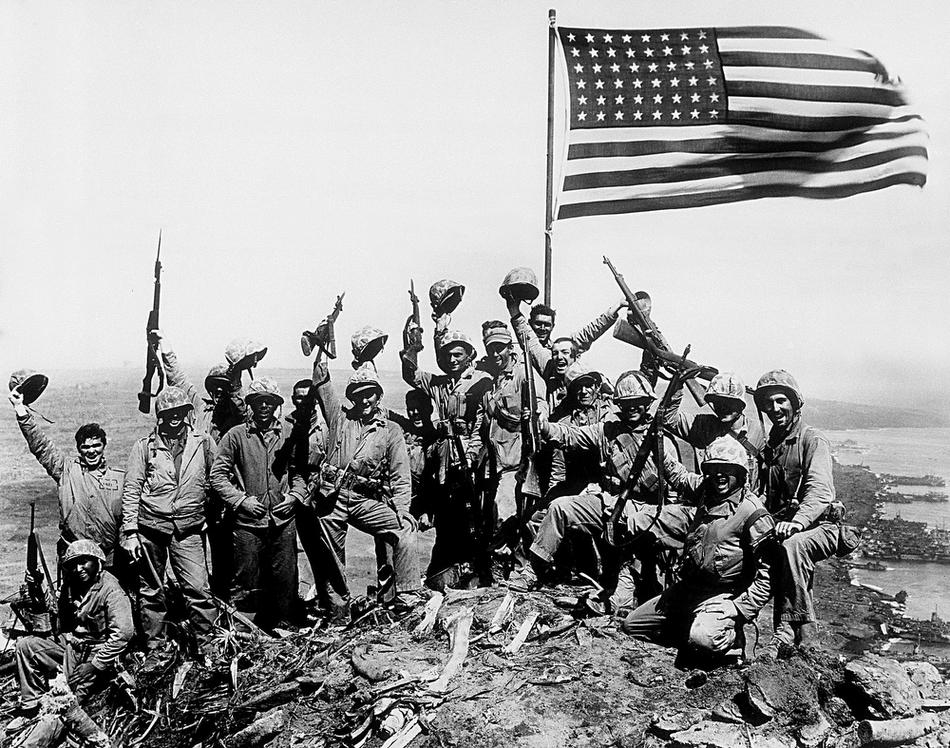
In a second photo Rosenthal shot at Iwo Jima, Marines pose in front of the flag they just raised. (AP Photo/Joe Rosenthal)
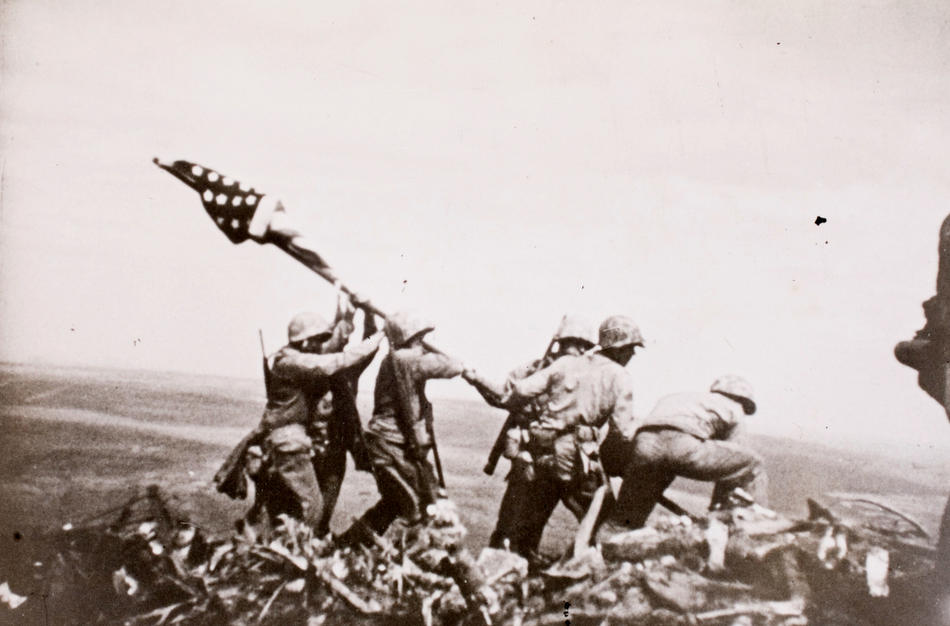
This black-and-white photo provided by the National Archives shows Marines raising the Old Glory on the summit of Iwo Jima's Mount Suribachi, is an enlargement from sixteen millimeter movie frame exposed by Marine Combat Photographer Sgt. William H. Genaust on February 23, 1945. Sgt. Genaust was attached to the Fifth Marine Division and worked shoulder to shoulder with Associated Press cameraman Joe Rosenthal at the time of the historic incident. (AP Photo/William H. Genaust)
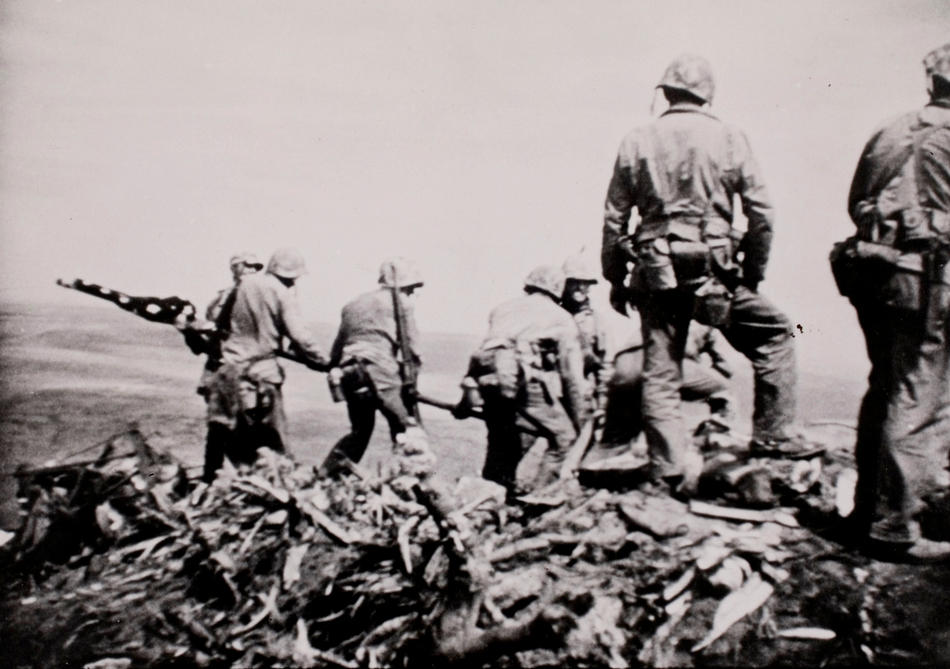
This black-and-white photo provided by the National Archives shows Marines raising the Old Glory on the summit of Iwo Jima's Mount Suribachi, is an enlargement from sixteen millimeter movie frame exposed by Marine Combat Photographer Sgt. William H. Genaust on February 23, 1945. Sgt. Genaust was attached to the Fifth Marine Division and worked shoulder to shoulder with Associated Press cameraman Joe Rosenthal at the time of the historic incident. (AP Photo/Files/William H. Genaust)
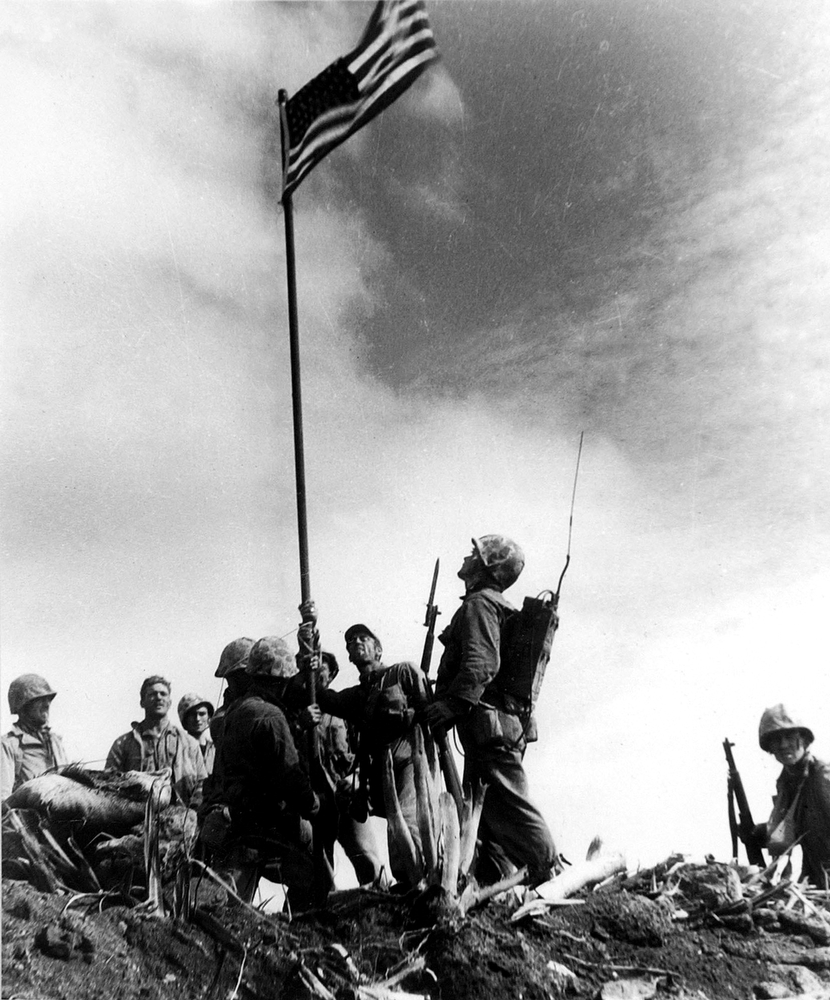
United States Marines from the 5th Division of the 28th Regiment gather around a U.S. flag they raised atop Mt. Suribachi on Iwo Jima during World War II, Feb. 23, 1945. This was the first flag raised by the Marine Corps at Iwo Jima. The raising of a second, larger flag later that day was made famous in the prize-winning photo by Associated Press photographer Joe Rosenthal. (AP Photo/U.S. Marine Corp, Sgt. Louis R. Lowery, File)
THE REACTION:
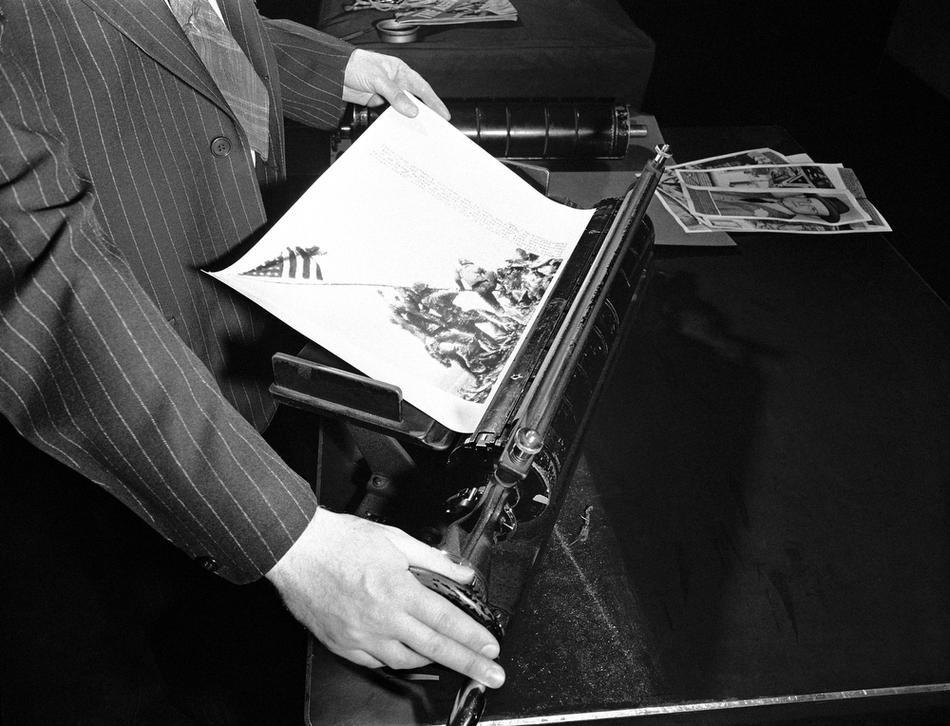
The photo of the Iwo Jima flag-raising runs off the AP wire, April 3, 1945. Joe Rosenthal won a Pulitzer Prize for the photo. (AP Photo)
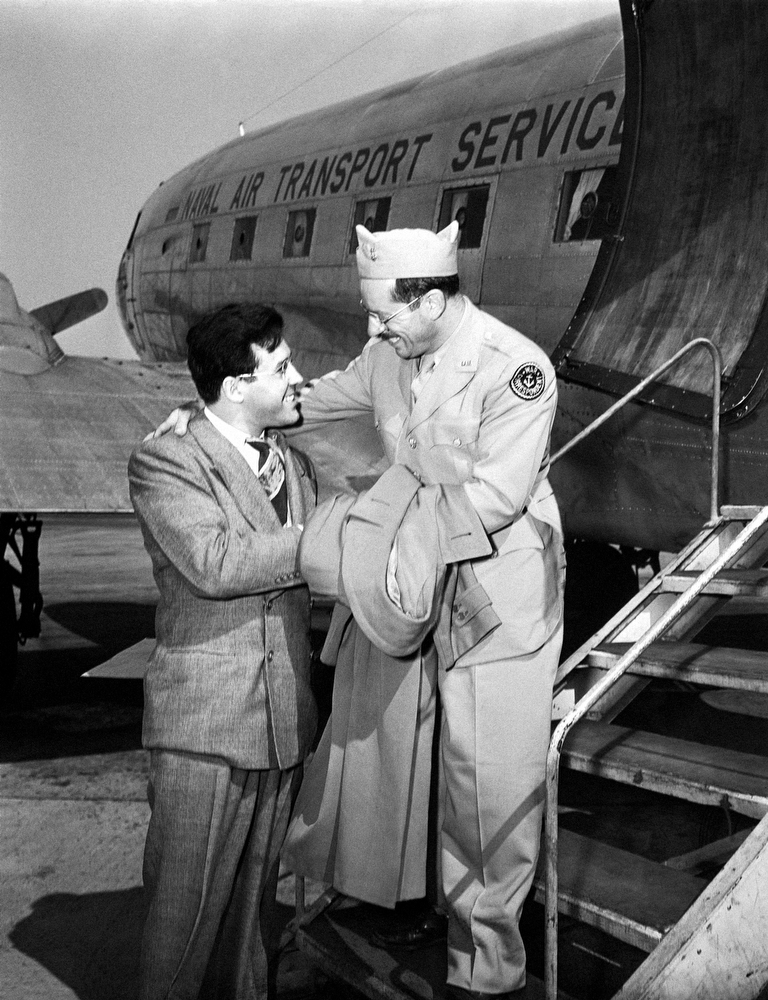
Joe Rosenthal, right, is greeted by his brother William upon his arrival in his home town, Washington, March 26, 1945. The Associated Press photographer, with the wartime still picture pool, who made the famous picture of the Marines hoisting the American flag over Mt. Suribachi on lwo Jima, spent one hour with his brother. (AP Photo/Robert Clover)
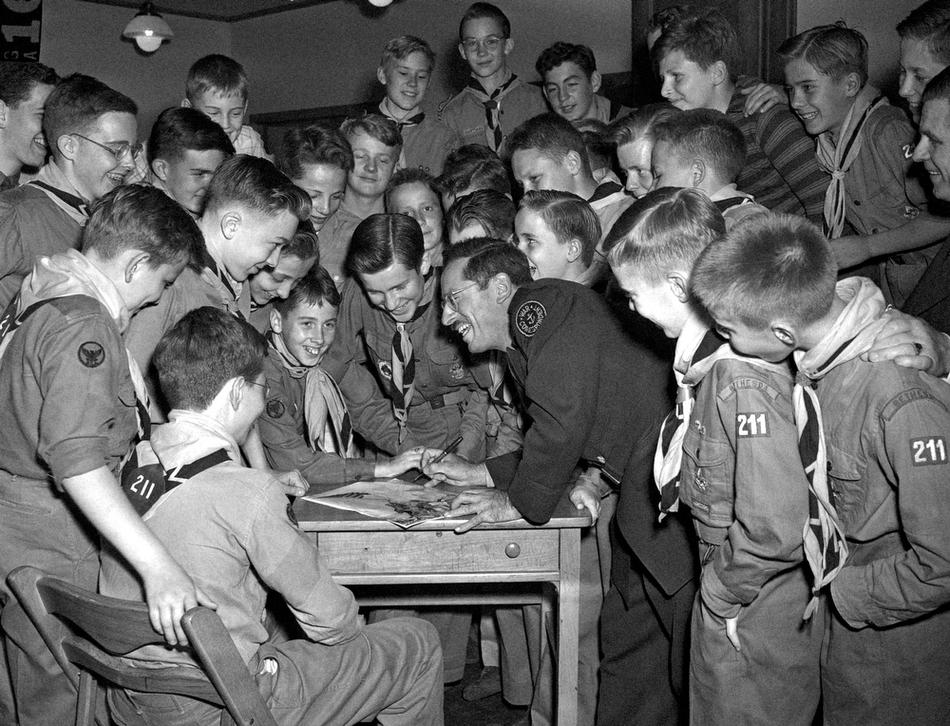
Members of Boy Scout troop 211 gather around Associated Press photographer Joe Rosenthal, in their meeting room at Bethesda, Md., March 30, 1945, as he autographs copies of his famous Iwo Jima picture. (AP Photo)
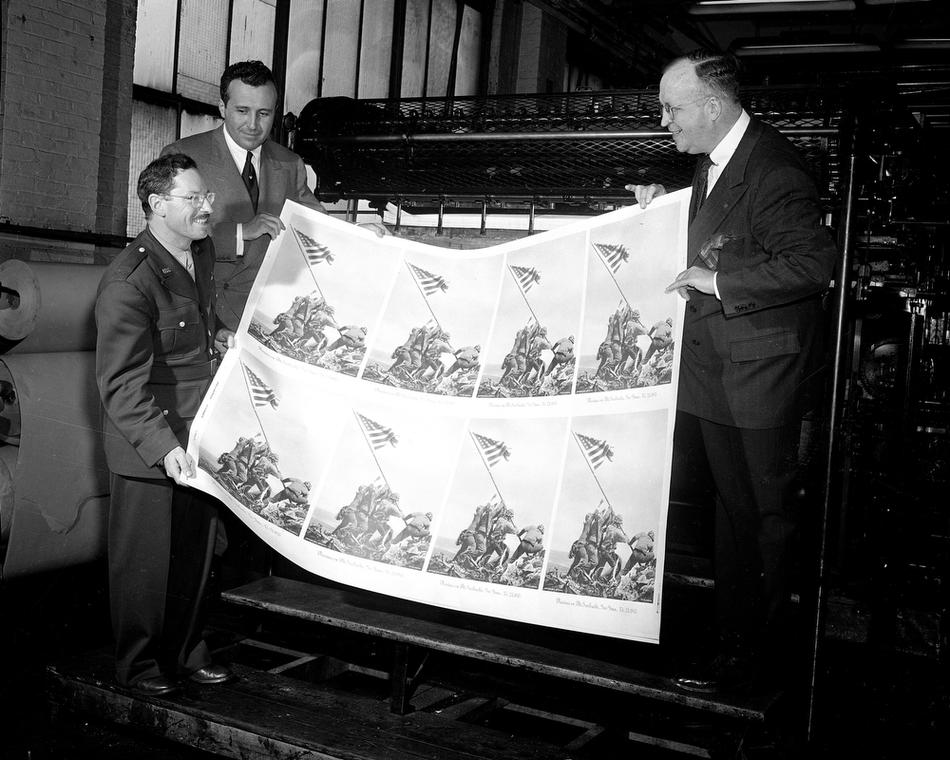
AP war photographer Joe Rosenthal, bottom left, looks at color prints of his Iwo Jima flag raising photo at the Einsen-Freeman Co. in Queens section of New York, April 1945. With him, from left to right are Albert Hailparn, and William Adams, vice president of Einsen-Freeman. (AP Photo/Murray Becker)
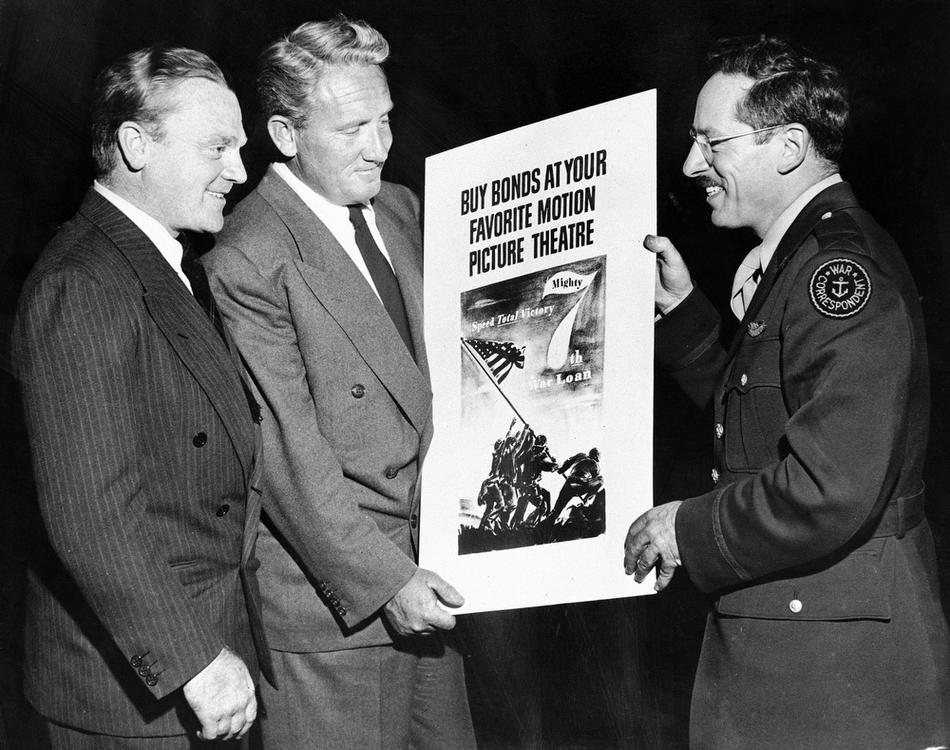
Actors James Cagney, left, and Spencer Tracy, center, show AP photographer Joe Rosenthal, right, one of the posters to be used in the movie industry's war loan drive, April 10, 1945. (AP Photo/U.S. Treasury Dept.)
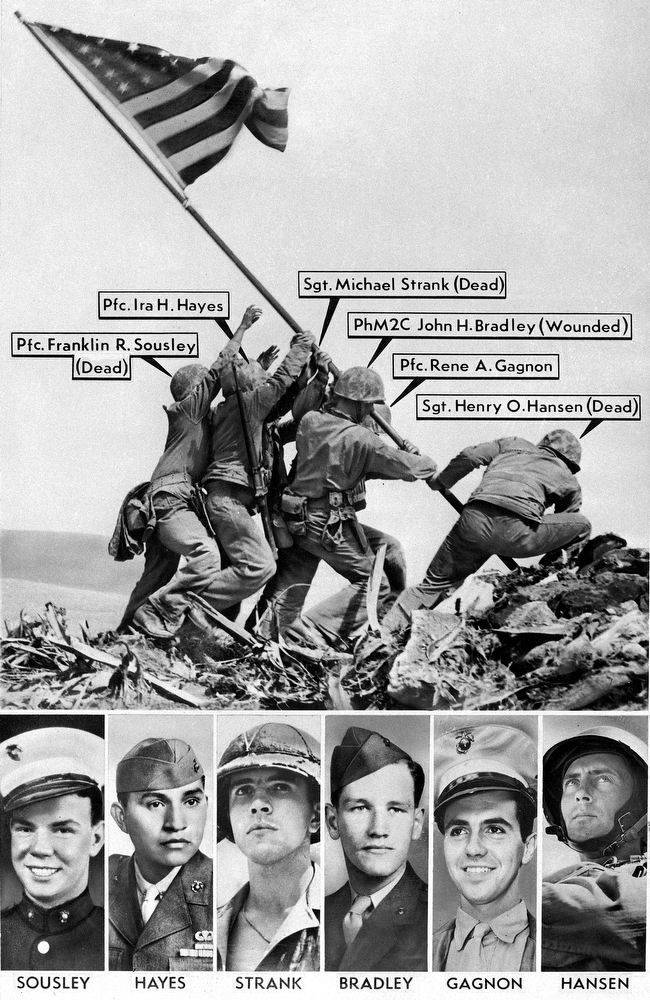
Joe Rosenthal's Pulitzer Prize winning AP photo of the Feb. 23, 1945 flag raising on Mt. Suribachi, Iwo Jima, was originally misidentified by military sources. Originally identified, from left, in this vintage graphic: Pfc. Franklin R. Sousley; Pfc. Ira Hayes; Sgt. Michael Strank; Pharmacist's Mate 2nd Class John H. Bradley; Pfc. Rene A. Gagnon; Sgt. Henry O. Hansen. The Marine at far right was later correctly identified as Cpl. Harlon Block, not Hansen. (AP Photo/Joe Rosenthal)
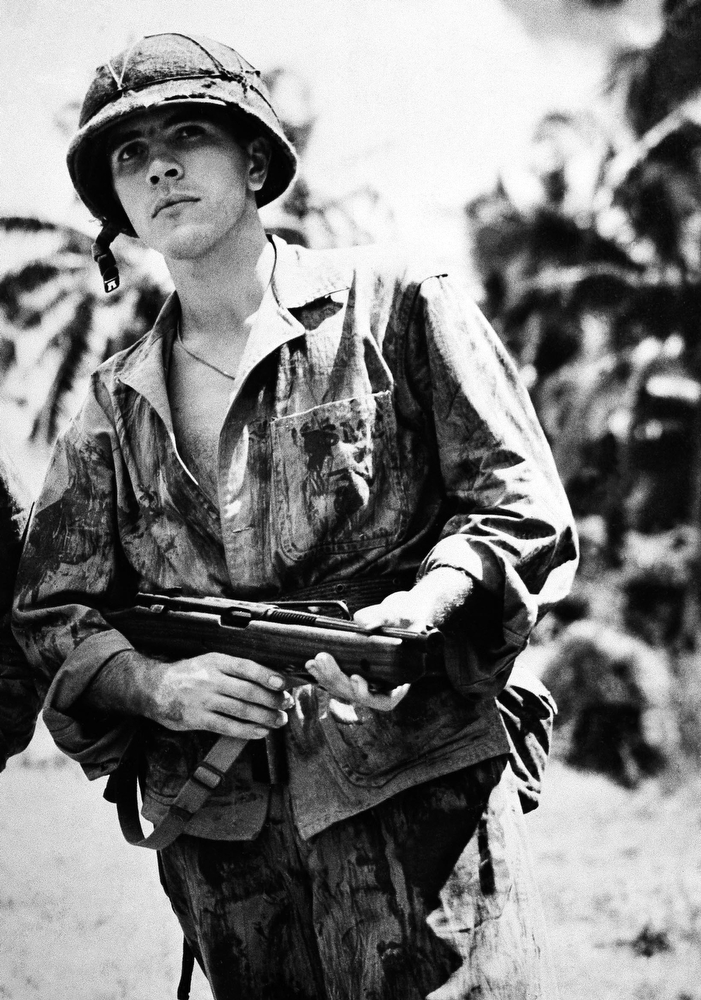
Marine Sgt. Michael Strank of Conemaugh, PA., reported killed in action on Iwo Jima, was identified on April 8, 1945 as one of the marines shown raising the stars and stripes on Mount Suribachi in Associated Press photographer Joe Rosenthal's historic picture. (AP Photo)
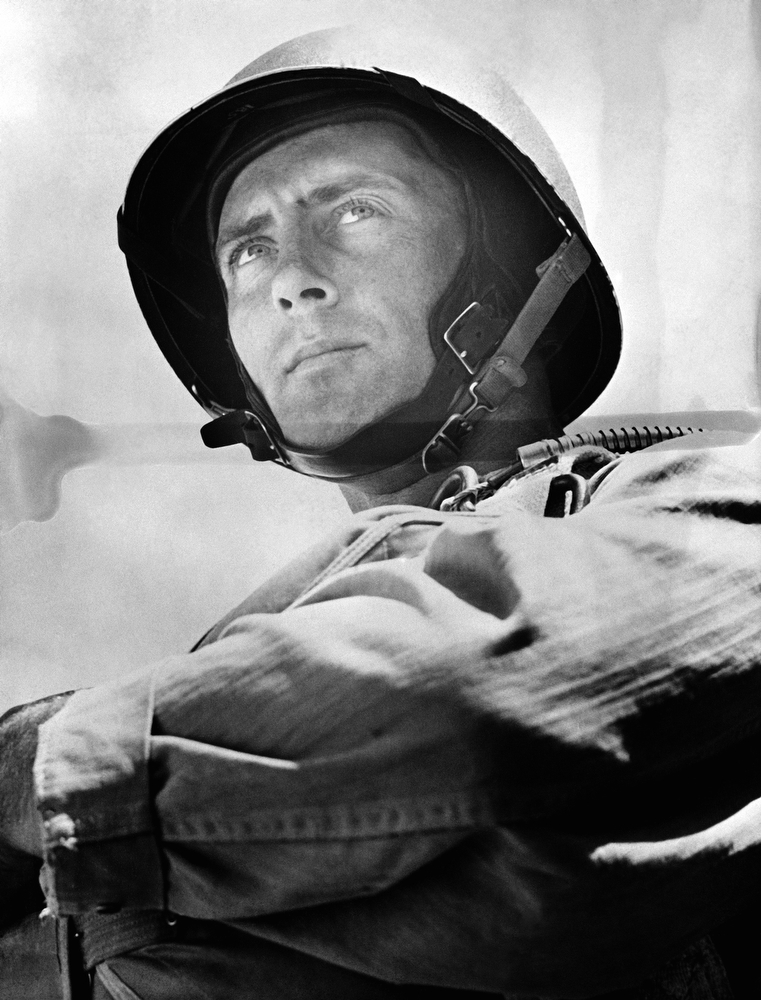
Marine Sgt. Henry O. Hansen, 24, of Somerville, Mass., has been identified as a participant in the dramatic flag-raising picture taken on Iwo Jima by Associated Press photographer Joe Rosenthal. Hansen was identified by Marine Pfc. Rene Gagnon, one of the three surviving soldiers of the six-man group. (AP Photo)
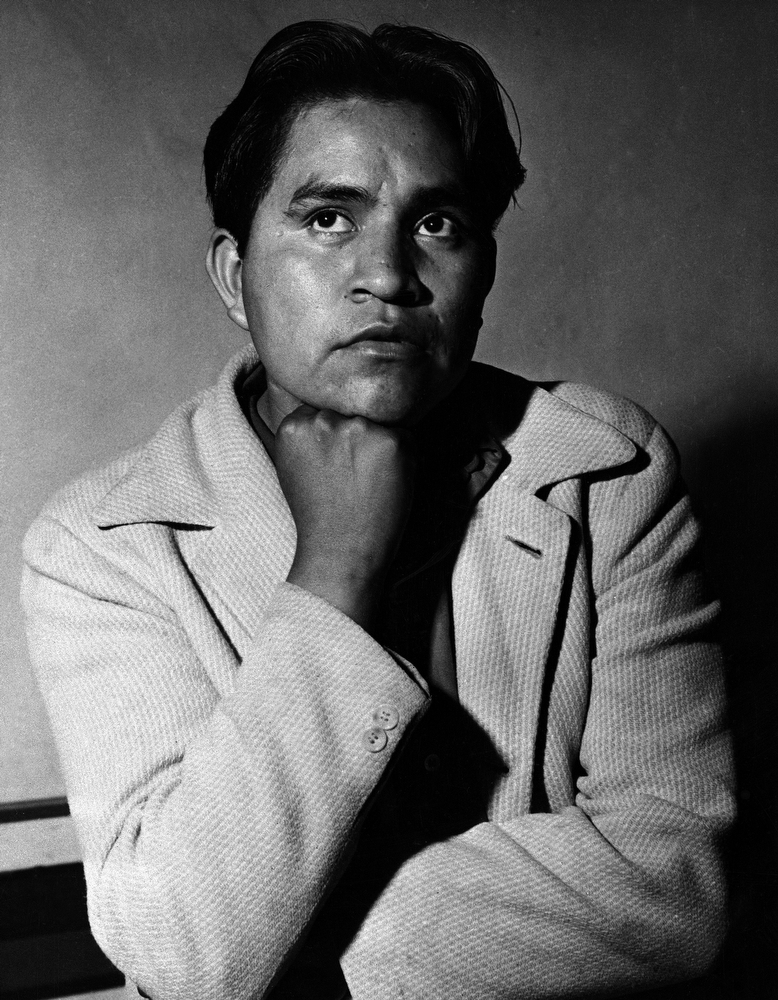
Ira Hayes, one of the six Marines who raised the flag in Iwo Jima, as depicted in Joe Rosenthal's famous photograph, is seen Feb. 21, 1947. (AP Photo)
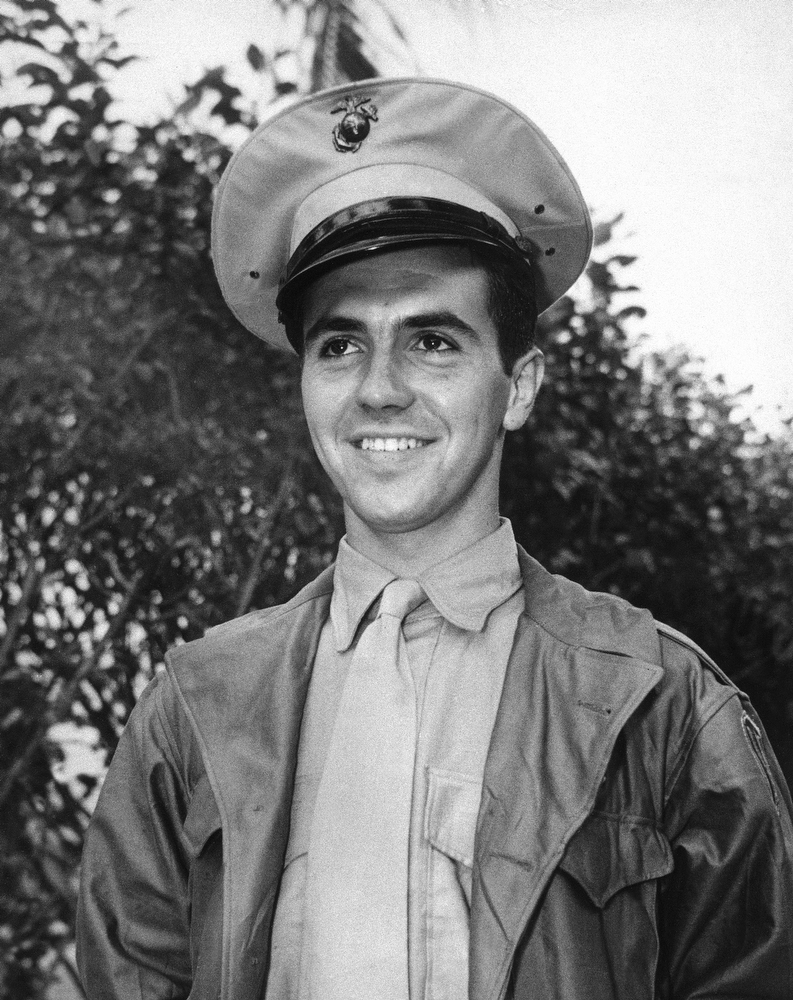
Pfc. Rene A. Gagnon, one of the six Marines who raised the flag at Iwo Jima atop Mt. Suribachi, is seen April 5, 1945. He was rushing a new battery to a radio unit when he paused to help raise the flag and was immortalized in Joe Rosenthal's famous photo. (AP Photo/Staff Sgt. Fedrico Claveria/USMC)
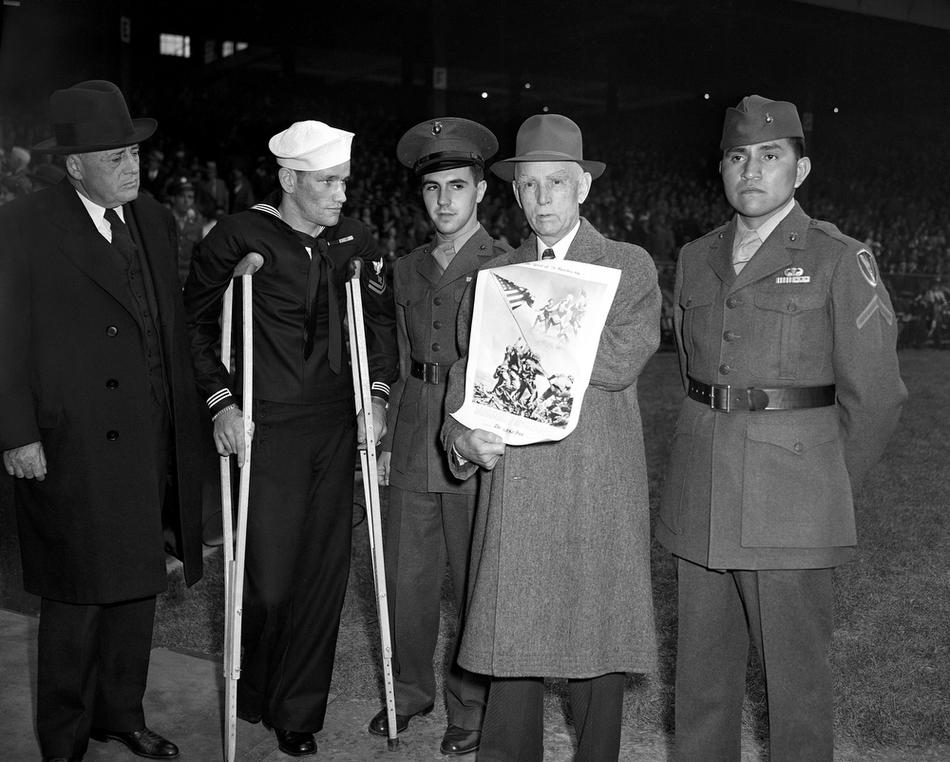
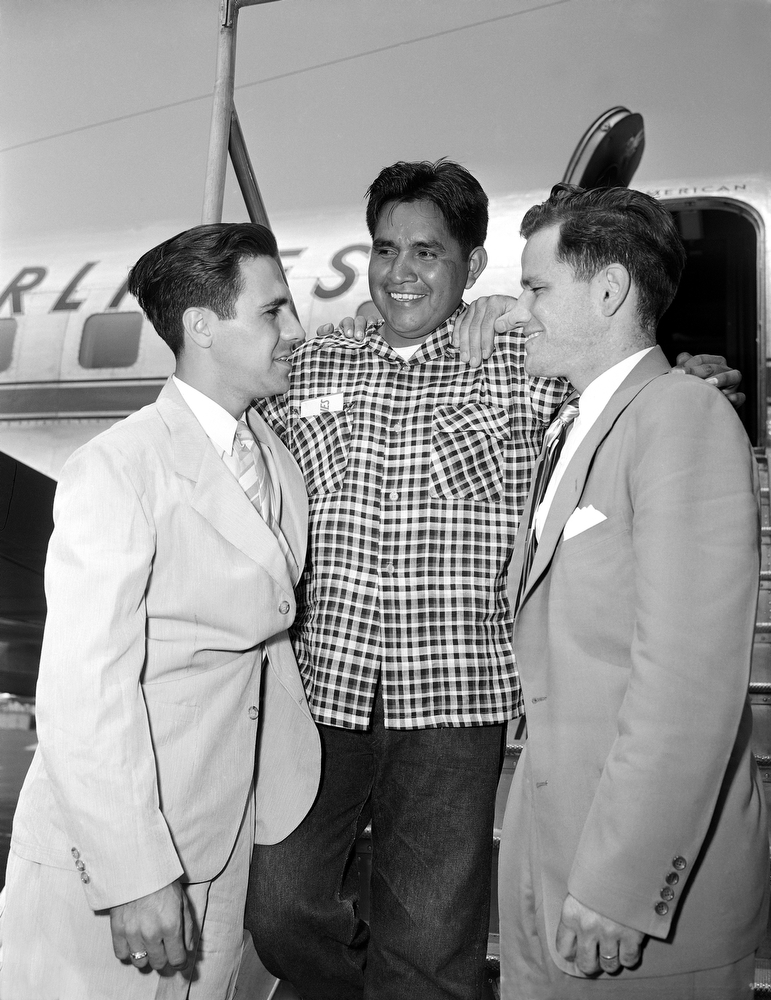
The three surviving Marines who were in the famous photograph of the flag raising on Mt. Suribachi, Iwo Jima, are reunited in Los Angeles for the first time since the war on July 25, 1949. They are en route to Camp Pendleton to reenact their heroic roles in a movie, "The Sands of Iwo Jima." Keft to right are: Rene Gagnon, Ira Hayes and John Bradley. (AP Photo/Ira W. Guldner)
Three survivors of the famous Iwo Jima flag raising on Mt. Suribachi attend a Washington Nationals-New York Yankees game in Wash. DC, April 20, 1945. From left to right: House Speaker Sam Rayburn, D-Tex; pharmacist's mate 2nd Class John H. Bradley of Wisconsin; Pfc. Rene A. Gagnon of New Hampshire; Nat's owner Clark Griffith, holding new 7th War Loan poster; and Pfc. Ira Hayes of Arizona. (AP Photo/Max Desfor)
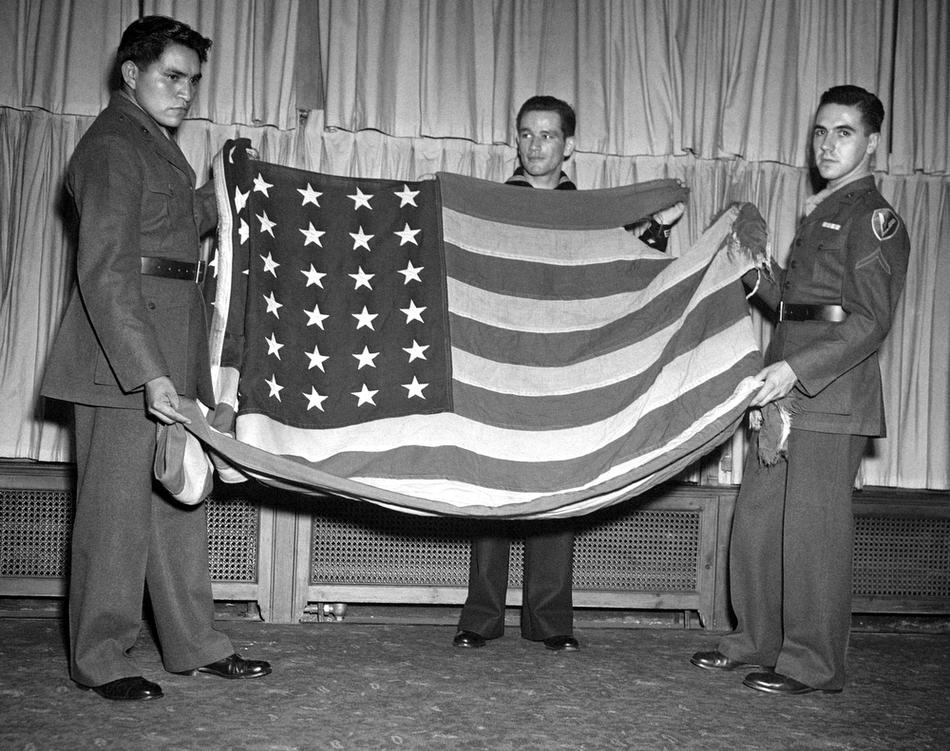
Holding the original Iwo Jima flag shown in the flag-raising photo made by AP staffer Joe Rosenthal, from left to right: Pvt. Ira Hayes, U.S. Marine Corp.; pharmacist's mate John H. Bradley, U.S. Navy; Pvt. Rene Gagnon, U.S. Marine Corp. All three, seen in New York, May 11, 1945, appear in the Iwo Jima photo. (AP Photo/John Lindsay)
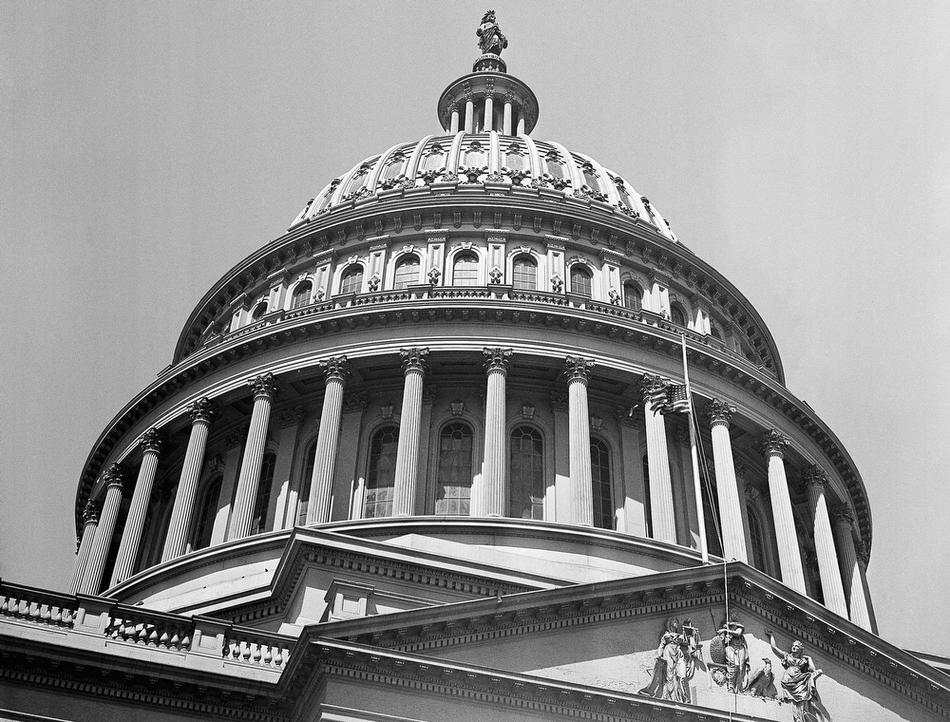
The flag raised by Marines on Mt. Suribachi on Iwo Jima and subject of the Pulitzer Prize-winning photo by Joe Rosenthal, Associated Press photographer with the wartime still picture pool, flutters at half staff at the capital, where it was flown on May 9, 1945, in mourning for President Roosevelt. (AP Photo/Joe Rosenthal)
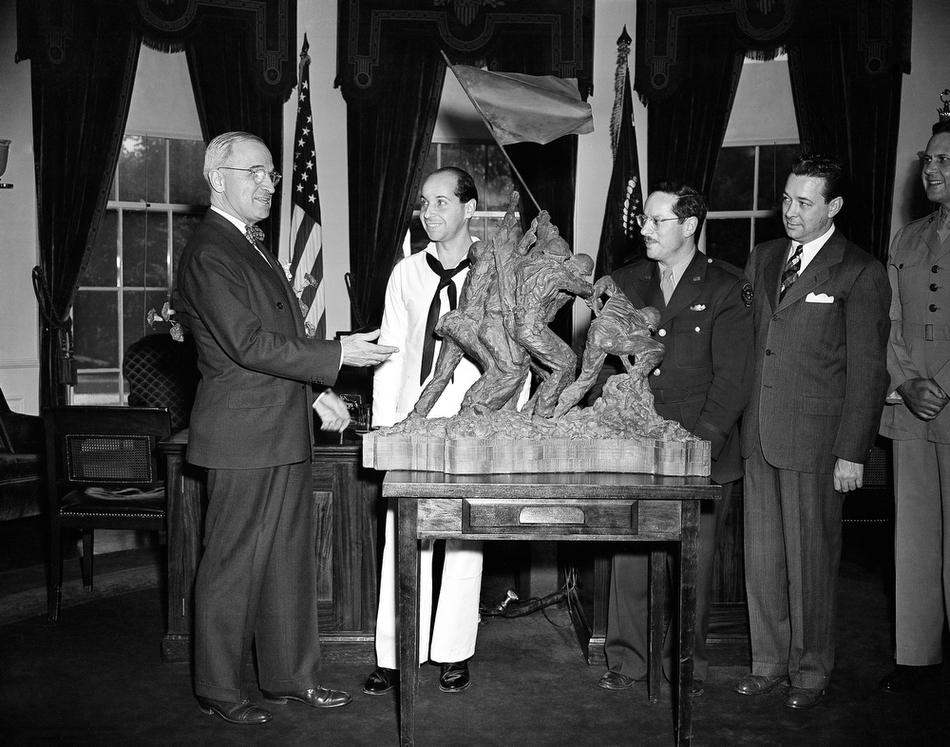
Marine Lt. Col. E.R. Hagenah, second from left, presents a bronze statue modeled after Associated Press photographer Joe Rosenthals picture of Marines raising the American Flag on Mt. Suribachi in Iwo Jima to Pres. Harry Truman, left, at the White House, June 4, 1945, Washington, D.C. Rosenthal is second from right and Felix Deweldon, sculpture of the statue, is at right. (AP Photo/Robert Clover)
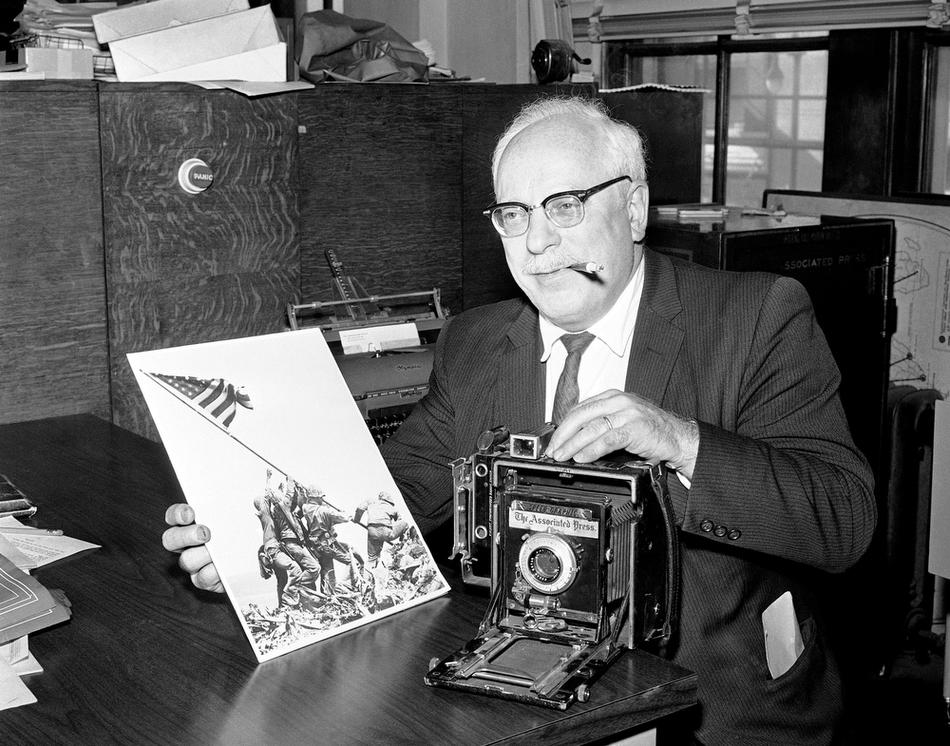
Former Associated Press photographer Joe Rosenthal holds his famous Pulitzer Prize-winning photo of the flag raising on Mount Suribachi as he poses in San Francisco, Feb. 18, 1965. The flag-raising photo was taken 20 years ago after the Marines landed on Iwo Jima during World War II. Rosenthal is now photographer for the San Francisco Chronicle. The photo, often described as the best of World War II, won Rosenthal the 1945 Pulitzer. (AP Photo)
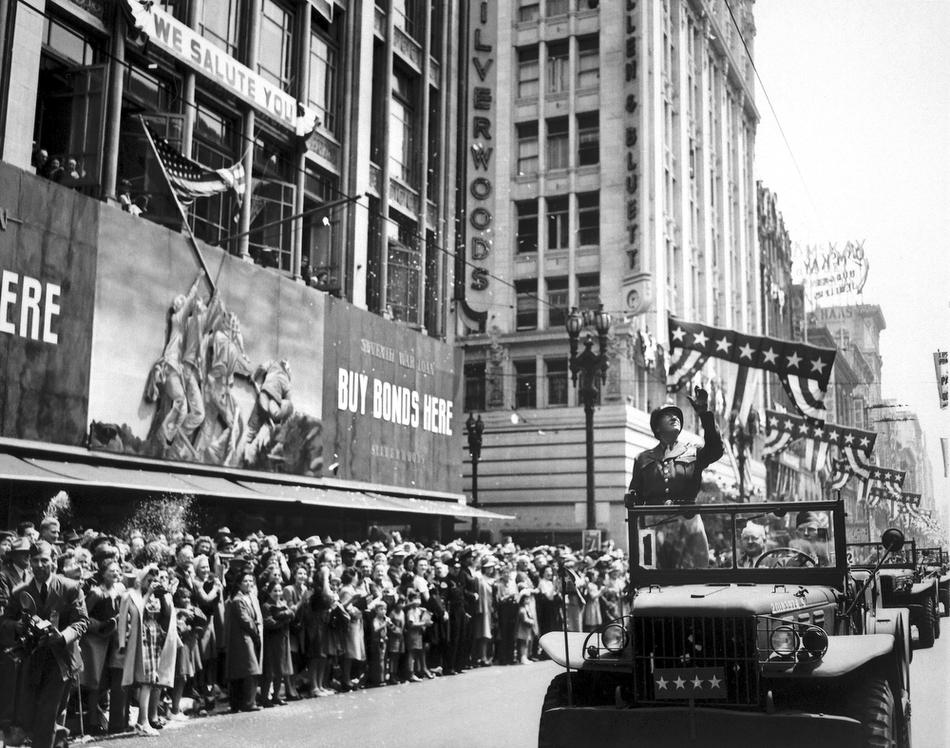
Gen. George S. Patton acknowledges the cheers of thousands during a parade through downtown Los Angeles,Calif., June 9, 1945. Shortly thereafter, Patton returned to Germany and controversy, as he advocated the employment of ex-Nazis in administrative positions in Bavaria; he was relieved of command of the 3rd Army and died of injuries from a traffic accident in December, after his return home. Joe Rosenthal's famous Iwo Jima flag-raising photograph is visible on the war bonds billboard. (AP Photo)
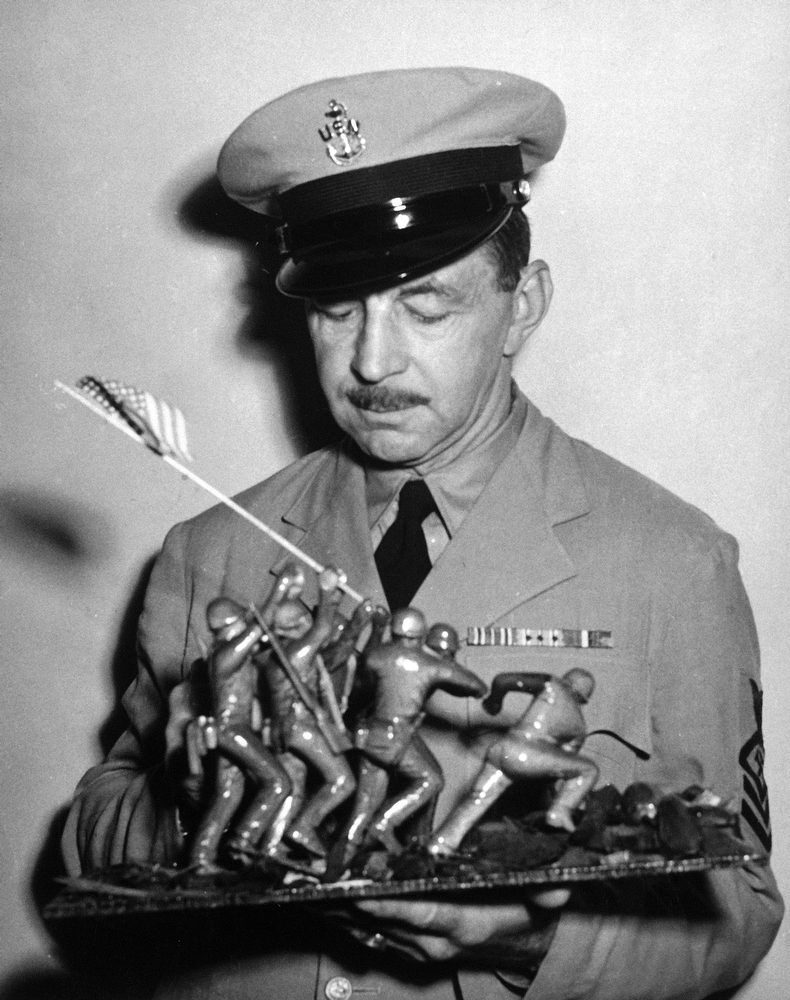
Unidentified Sailor, seen holding a wood carving depicting Joe Rosenthal's famous photo of the flag raising at Iwo Jima. (AP Photo)
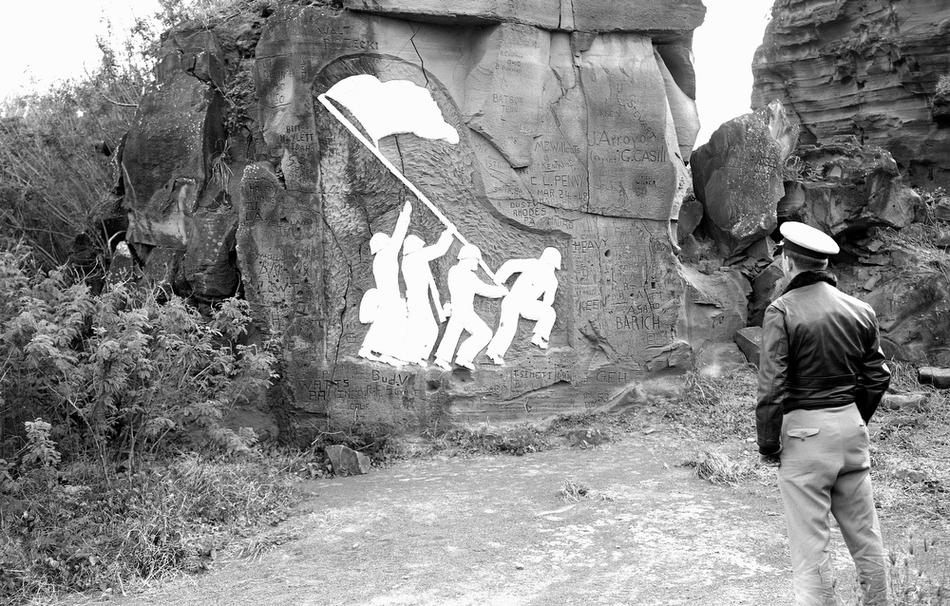
The Seabees left their imprints on this rock wall, featuring a sculptured duplicate of the famed flag-raising picture on Iwo Jima, Feb. 21, 1954. The Island of Iwo Jima is where the U.S. Marines climaxed their bloody victory by raising a flag atop the island's Mount Suribachi Feb. 23, 1945. The famed photograph was taken by Asscociated Press war photographer Joe Rosenthal. The sculpture is one of the sightseeing points on the island. (AP Photo)
Paul Marquis
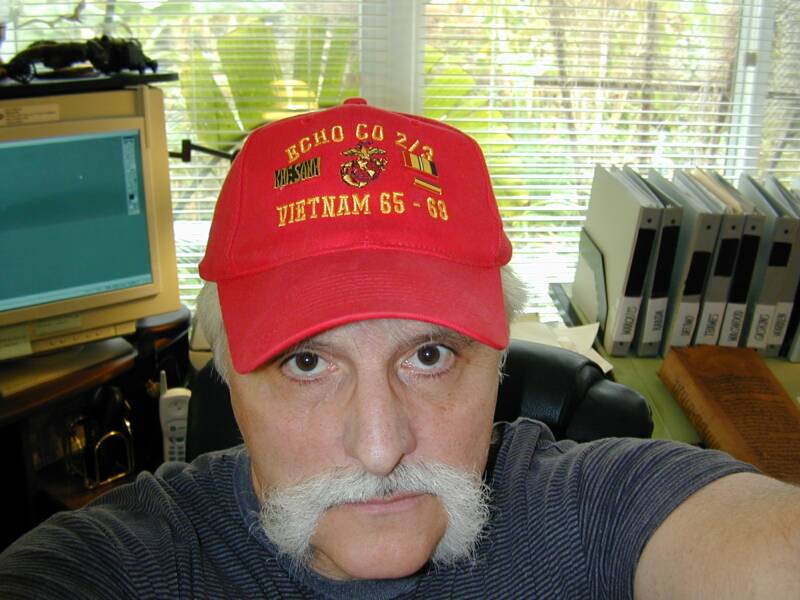
 | ||||||

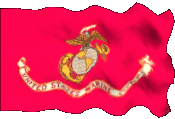
SOUND
CONTROL

